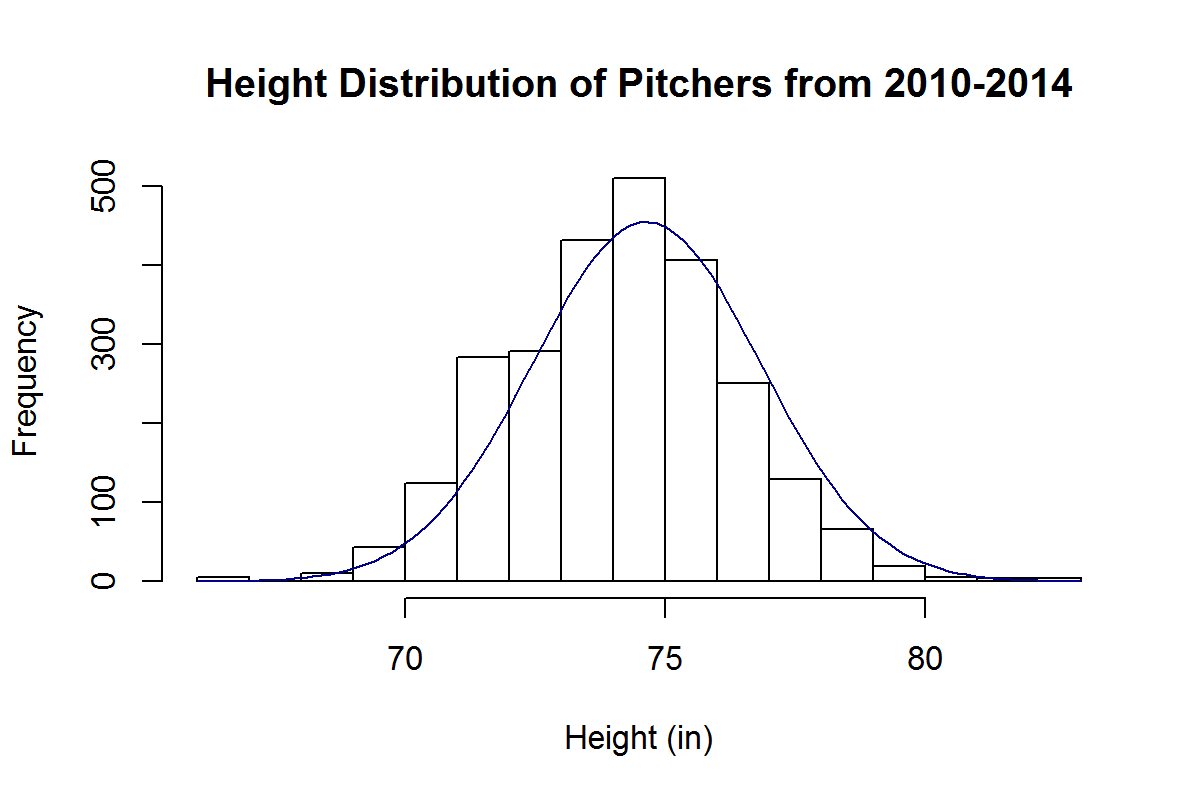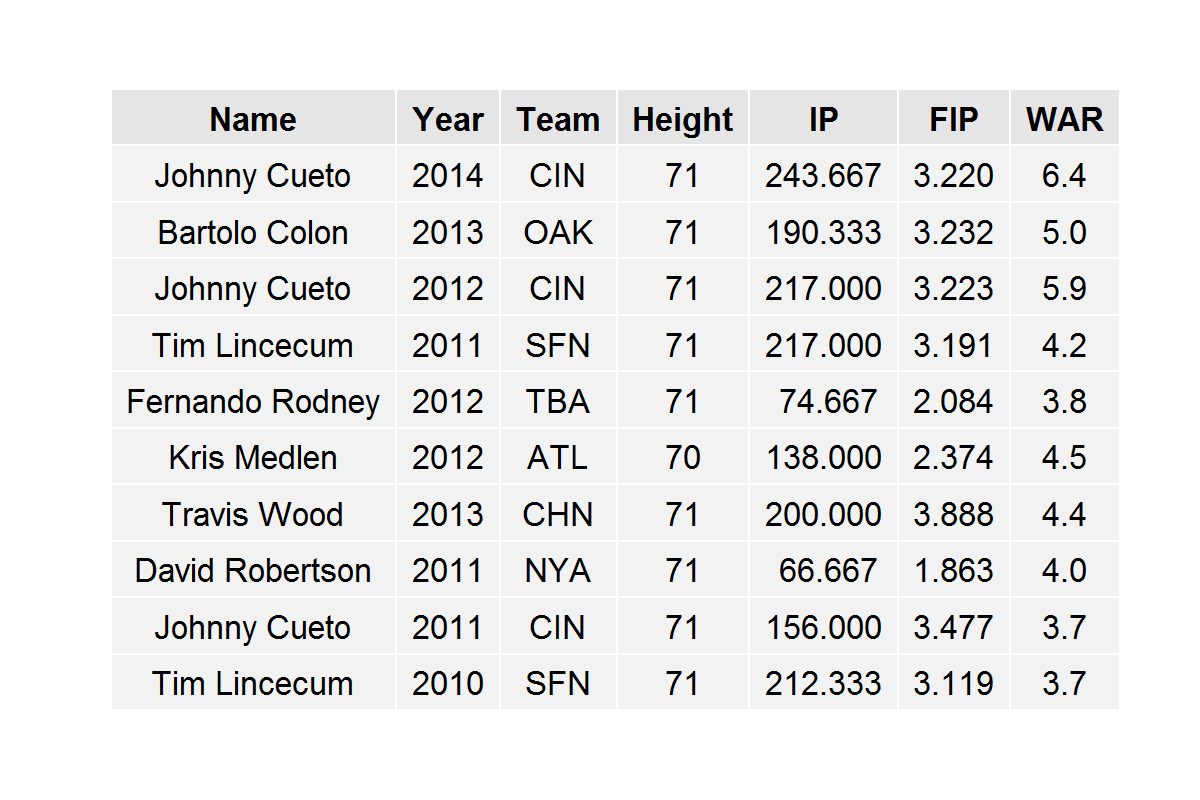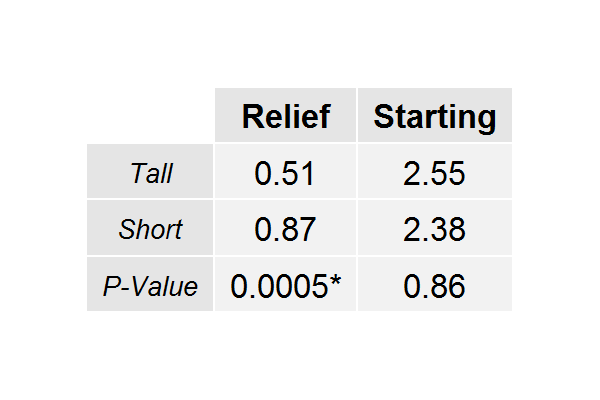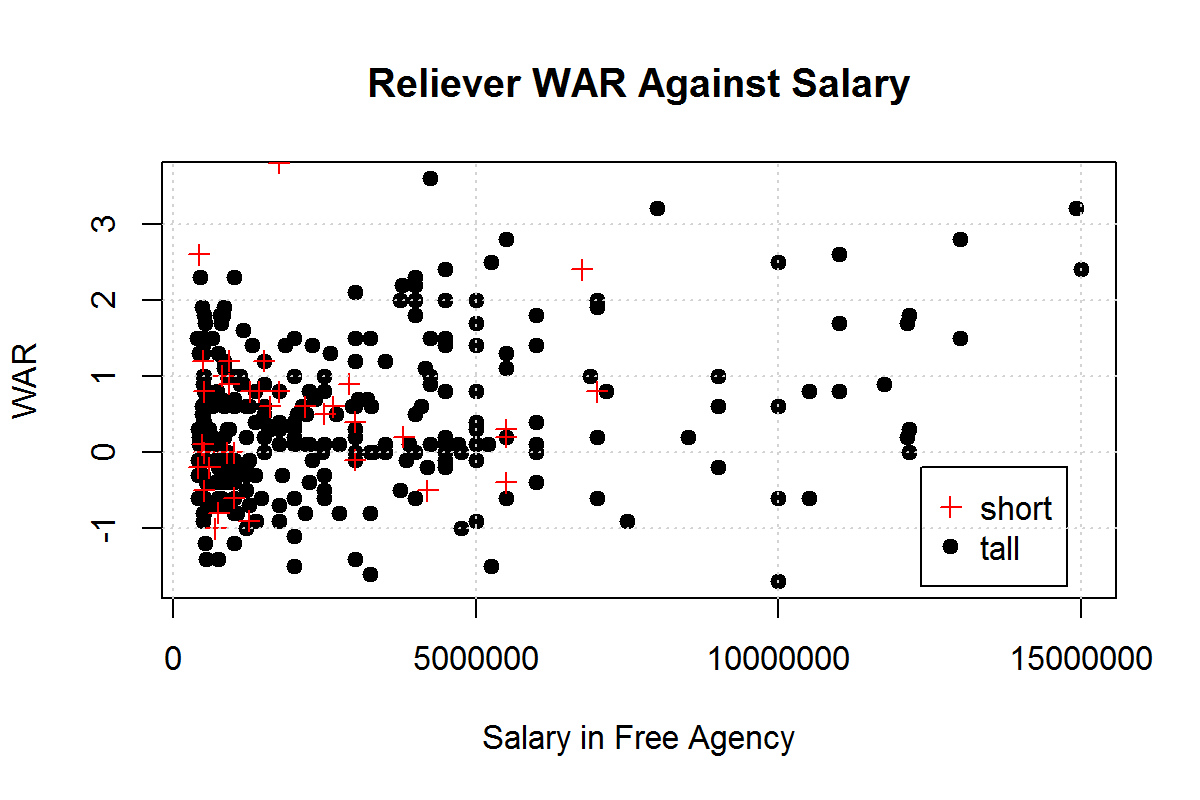How Many Elite Players Were Good Prospects?
I really enjoyed Jeff Sullivan’s piece on the prospect pedigree of good players, and it was interesting to see how many solid players never cracked the Baseball America 100 in any year. This is an extension of that article, and not a particularly original one. In fact, I think it’s about the most obvious next step: how many great players were prospects?
It was interesting to see that someone can have a decent season as a totally unheralded player, but there are a lot of players who have a 3-win season and promptly fade into ignominy. Players at that threshold in 2010 included Cliff Pennington and Dallas Braden, and in 2011, Emilio Bonifacio and Alexi Ogando. Cherry-picked names, to be sure, but it’s easy to imagine they (and players like them) are the source of that ~33% of un-ranked good players, and the real elite players are usually identified as at least good. That doesn’t mean it’s true, though, so I tested it.
I pulled the top 10 pitchers and the top 10 position players by WAR for each year from 2010 through 2014. If there was a tie for 10th, I included both players, so the sample ended up at 101 players. Then, for each player, I found their highest ranking on the BA lists. The same caveats as in Jeff’s article apply here, but again, BA is the industry standard, and their lists go back long enough to make them very useful. Following: a giant table, with every qualifying player-year, their WAR in that year (and how that ranked among all players), and their highest prospect ranking and the year of that ranking.
| Name | Season | Team | WAR | WAR Rank | Highest Prospect Rank | Prospect Rank Year |
| Mike Trout | 2013 | Angels | 10.5 | 1 | 2 | 2011 |
| Mike Trout | 2012 | Angels | 10.3 | 1 | 2 | 2011 |
| Jacoby Ellsbury | 2011 | Red Sox | 9.4 | 1 | 13 | 2008 |
| Josh Hamilton | 2010 | Rangers | 8.4 | 1 | 1 | 2001 |
| Roy Halladay | 2011 | Phillies | 8.4 | 1 | 12 | 1999 |
| Mike Trout | 2014 | Angels | 8.0 | 1 | 2 | 2011 |
| Clayton Kershaw | 2014 | Dodgers | 7.6 | 1 | 7 | 2008 |
| Clayton Kershaw | 2013 | Dodgers | 7.0 | 1 | 7 | 2008 |
| Cliff Lee | 2010 | – – – | 6.9 | 1 | 30 | 2003 |
| Justin Verlander | 2012 | Tigers | 6.7 | 1 | 8 | 2006 |
| Andrew McCutchen | 2013 | Pirates | 8.4 | 2 | 13 | 2007 |
| Matt Kemp | 2011 | Dodgers | 8.3 | 2 | 96 | 2006 |
| Carl Crawford | 2010 | Rays | 7.7 | 2 | 59 | 2002 |
| Buster Posey | 2012 | Giants | 7.7 | 2 | 7 | 2010 |
| Corey Kluber | 2014 | Indians | 7.2 | 2 | Unranked | Unranked |
| Clayton Kershaw | 2011 | Dodgers | 7.1 | 2 | 7 | 2008 |
| Andrew McCutchen | 2014 | Pirates | 6.8 | 2 | 13 | 2007 |
| Adam Wainwright | 2013 | Cardinals | 6.6 | 2 | 18 | 2003 |
| Roy Halladay | 2010 | Phillies | 6.2 | 2 | 12 | 1999 |
| Felix Hernandez | 2012 | Mariners | 6.2 | 2 | 2 | 2005 |
| Jose Bautista | 2011 | Blue Jays | 8.1 | 3 | Unranked | Unranked |
| Robinson Cano | 2012 | Yankees | 7.6 | 3 | Unranked | Unranked |
| Josh Donaldson | 2013 | Athletics | 7.6 | 3 | Unranked | Unranked |
| Evan Longoria | 2010 | Rays | 7.5 | 3 | 2 | 2008 |
| Cliff Lee | 2011 | Phillies | 6.8 | 3 | 30 | 2003 |
| Alex Gordon | 2014 | Royals | 6.6 | 3 | 2 | 2007 |
| Matt Harvey | 2013 | Mets | 6.5 | 3 | 54 | 2012 |
| Justin Verlander | 2010 | Tigers | 6.2 | 3 | 8 | 2006 |
| Felix Hernandez | 2014 | Mariners | 6.1 | 3 | 2 | 2005 |
| Clayton Kershaw | 2012 | Dodgers | 5.7 | 3 | 7 | 2008 |
| Dustin Pedroia | 2011 | Red Sox | 7.8 | 4 | 77 | 2006 |
| Carlos Gomez | 2013 | Brewers | 7.5 | 4 | 52 | 2008 |
| Chase Headley | 2012 | Padres | 7.5 | 4 | 32 | 2008 |
| Joey Votto | 2010 | Reds | 7.0 | 4 | 43 | 2007 |
| Anthony Rendon | 2014 | Nationals | 6.5 | 4 | 19 | 2012 |
| CC Sabathia | 2011 | Yankees | 6.4 | 4 | Unranked | Unranked |
| Jered Weaver | 2010 | Angels | 6.1 | 4 | 57 | 2006 |
| David Price | 2014 | – – – | 6.1 | 4 | 2 | 2009 |
| Max Scherzer | 2013 | Tigers | 6.0 | 4 | 66 | 2008 |
| David Price | 2012 | Rays | 5.1 | 4 | 2 | 2009 |
| David Wright | 2012 | Mets | 7.4 | 5 | 21 | 2004 |
| Miguel Cabrera | 2013 | Tigers | 7.4 | 5 | 12 | 2003 |
| Ian Kinsler | 2011 | Rangers | 7.2 | 5 | 98 | 2005 |
| Albert Pujols | 2010 | Cardinals | 6.8 | 5 | 42 | 2001 |
| Josh Donaldson | 2014 | Athletics | 6.5 | 5 | Unranked | Unranked |
| Dan Haren | 2011 | Angels | 6.4 | 5 | Unranked | Unranked |
| Felix Hernandez | 2010 | Mariners | 6.0 | 5 | 2 | 2005 |
| Anibal Sanchez | 2013 | Tigers | 5.9 | 5 | 40 | 2006 |
| Phil Hughes | 2014 | Twins | 5.7 | 5 | 4 | 2007 |
| Cliff Lee | 2012 | Phillies | 5.1 | 5 | 30 | 2003 |
| Ryan Braun | 2012 | Brewers | 7.3 | 6 | 26 | 2007 |
| Chris Davis | 2013 | Orioles | 7.1 | 6 | 65 | 2008 |
| Ryan Braun | 2011 | Brewers | 7.1 | 6 | 26 | 2007 |
| Ryan Zimmerman | 2010 | Nationals | 6.6 | 6 | 15 | 2006 |
| Michael Brantley | 2014 | Indians | 6.3 | 6 | Unranked | Unranked |
| Justin Verlander | 2011 | Tigers | 6.3 | 6 | 8 | 2006 |
| Ubaldo Jimenez | 2010 | Rockies | 5.9 | 6 | 82 | 2005 |
| Felix Hernandez | 2013 | Mariners | 5.7 | 6 | 2 | 2005 |
| Jon Lester | 2014 | – – – | 5.6 | 6 | 22 | 2006 |
| Gio Gonzalez | 2012 | Nationals | 5 | 6 | 26 | 2008 |
| Matt Carpenter | 2013 | Cardinals | 6.9 | 7 | Unranked | Unranked |
| Curtis Granderson | 2011 | Yankees | 6.8 | 7 | 57 | 2005 |
| Andrew McCutchen | 2012 | Pirates | 6.8 | 7 | 13 | 2007 |
| Jose Bautista | 2010 | Blue Jays | 6.4 | 7 | Unranked | Unranked |
| Giancarlo Stanton | 2014 | Marlins | 6.2 | 7 | 3 | 2010 |
| Jered Weaver | 2011 | Angels | 5.9 | 7 | 57 | 2006 |
| Josh Johnson | 2010 | Marlins | 5.8 | 7 | 80 | 2006 |
| Cliff Lee | 2013 | Phillies | 5.5 | 7 | 30 | 2003 |
| Jordan Zimmermann | 2014 | Nationals | 5.3 | 7 | 41 | 2009 |
| Zack Greinke | 2012 | – – – | 5.0 | 7 | 14 | 2004 |
| Evan Longoria | 2013 | Rays | 6.7 | 8 | 2 | 2008 |
| Alex Gordon | 2011 | Royals | 6.6 | 8 | 2 | 2007 |
| Adrian Beltre | 2012 | Rangers | 6.5 | 8 | 3 | 1998 |
| Adrian Beltre | 2010 | Red Sox | 6.4 | 8 | 3 | 1998 |
| Jose Bautista | 2014 | Blue Jays | 6.2 | 8 | Unranked | Unranked |
| Francisco Liriano | 2010 | Twins | 5.7 | 8 | 6 | 2006 |
| Doug Fister | 2011 | – – – | 5.2 | 8 | Unranked | Unranked |
| Chris Sale | 2014 | White Sox | 5.1 | 8 | 20 | 2011 |
| R.A. Dickey | 2012 | Mets | 4.9 | 8 | Unranked | Unranked |
| Mat Latos | 2013 | Reds | 4.8 | 8 | Unranked | Unranked |
| Miguel Cabrera | 2011 | Tigers | 6.5 | 9 | 12 | 2003 |
| Jason Heyward | 2012 | Braves | 6.5 | 9 | 1 | 2010 |
| Robinson Cano | 2010 | Yankees | 6.3 | 9 | Unranked | Unranked |
| Paul Goldschmidt | 2013 | Diamondbacks | 6.3 | 9 | Unranked | Unranked |
| Jonathan Lucroy | 2014 | Brewers | 6.2 | 9 | Unranked | Unranked |
| Adam Wainwright | 2010 | Cardinals | 5.6 | 9 | 18 | 2003 |
| Jake Arrieta | 2014 | Cubs | 5.1 | 9 | 67 | 2009 |
| Matt Cain | 2011 | Giants | 5 | 9 | 10 | 2006 |
| Justin Verlander | 2013 | Tigers | 4.8 | 9 | 8 | 2006 |
| Johnny Cueto | 2012 | Reds | 4.7 | 9 | 34 | 2008 |
| Joey Votto | 2011 | Reds | 6.4 | 10 | 43 | 2007 |
| Miguel Cabrera | 2012 | Tigers | 6.4 | 10 | 12 | 2003 |
| Andres Torres | 2010 | Giants | 6.3 | 10 | Unranked | Unranked |
| Manny Machado | 2013 | Orioles | 6.2 | 10 | 11 | 2012 |
| Carlos Gomez | 2014 | Brewers | 5.7 | T-10 | 52 | 2008 |
| Adrian Beltre | 2014 | Rangers | 5.7 | T-10 | 3 | 1998 |
| CC Sabathia | 2010 | Yankees | 5.1 | 10 | Unranked | Unranked |
| Max Scherzer | 2014 | Tigers | 5.1 | 10 | 66 | 2008 |
| Matt Garza | 2011 | Cubs | 5.0 | 10 | 21 | 2007 |
| CC Sabathia | 2012 | Yankees | 4.7 | 10 | Unranked | Unranked |
| Chris Sale | 2013 | White Sox | 4.7 | 10 | 20 | 2011 |
That is a big, ugly table, so here are some summary facts. Of this 101-player sample, 20 were never ranked by Baseball America, so indeed, top players appear to be more likely to have been a ranked prospect (80%) than good players (66%, per Jeff’s article). None of the unranked players were ever the best position player or pitcher in 2010-2014; the 1st place player with the lowest ranking was Cliff Lee, who topped out at 30th in 2003. The unranked players tended to be concentrated toward the bottom of the WAR leaderboards; 75% of the unranked players had a rank of 5th through 10th. I expected more of the people in 8th through 10th in a given season to be beneficiaries of a fluke season, but there are a lot fewer of those than I expected. The unranked players with the least impressive careers outside their top seasons are probably Andres Torres and RA Dickey, but the other unranked players are pretty uniformly great. Maybe not top-10-WAR-every-year-great, but still, great.
What about pitchers versus position players? If the top 10 by WAR of one group was more likely to include unranked players than the other, that would suggest that group was more difficult to scout and accurately predict. But while the split between pitchers and hitters among the unranked players is not totally even, 12 to 8, it’s well within what I would expect from random variation. Maybe a bigger sample could pull something meaningful out, but I’m not comfortable concluding there’s a difference based on this alone.
The following chart digs more into the individual ranks in each season. The x-axis is the WAR rank, and the bar height is the percentage of players at that point that were in the BA top 100. The line running across the chart is the average BA ranking of the players that were ranked.

What this shows is a pretty steady decline in the percentage of players ranked in the BA Top 100 as you move down the WAR leaderboard, and a totally random average ranking of those ranked players. This fits with my perception of prospect rankings – being good enough to be ranked is pretty important, but the exact position on those rankings is not very predictive. As Jeff showed, it’s very tough to be good without being ranked, but this suggests it’s not tough for a prospect to be ranked as if he’ll be merely good, but be great some season.
What about consistent greatness? This list I created really doesn’t capture the best players of the last five years, but the best player-seasons. Can someone be really excellent over a sustained period of time if they weren’t ranked? For this, rather than looking at individual seasons, I grabbed the top 25 hitters and the top 25 pitchers by total WAR from 2010 through 2014. I thought about doing several five-year periods, but I didn’t want to double-count someone like Miguel Cabrera, who would show up for both 2010-14 and 2009-13. Below, a slightly less-giant table than the first, containing similar information: their WAR from 2010-2014, their highest BA ranking (if any), and the year that ranking came in.
| Name | Team | WAR | Highest Prospect Rank | Year |
| Clayton Kershaw | Dodgers | 32.2 | 7 | 2008 |
| Miguel Cabrera | Tigers | 31.4 | 12 | 2003 |
| Andrew McCutchen | Pirates | 30.9 | 13 | 2007 |
| Robinson Cano | – – – | 29.9 | Unranked | Unranked |
| Mike Trout | Angels | 29.5 | 2 | 2011 |
| Adrian Beltre | – – – | 29.1 | 3 | 1998 |
| Felix Hernandez | Mariners | 28.9 | 2 | 2005 |
| Jose Bautista | Blue Jays | 27.8 | Unranked | Unranked |
| Justin Verlander | Tigers | 26.7 | 8 | 2006 |
| Ben Zobrist | Rays | 26.7 | Unranked | Unranked |
| Cliff Lee | – – – | 26.2 | 30 | 2003 |
| Joey Votto | Reds | 26.2 | 43 | 2007 |
| Evan Longoria | Rays | 26.1 | 2 | 2008 |
| Dustin Pedroia | Red Sox | 24.9 | 77 | 2006 |
| David Price | – – – | 24.5 | 2 | 2009 |
| Buster Posey | Giants | 23.8 | 7 | 2010 |
| Matt Holliday | Cardinals | 22.8 | Unranked | Unranked |
| Troy Tulowitzki | Rockies | 22.7 | 15 | 2007 |
| Chase Headley | – – – | 22 | 32 | 2008 |
| Cole Hamels | Phillies | 21.9 | 17 | 2004 |
| Alex Gordon | Royals | 21.7 | 2 | 2007 |
| Jason Heyward | Braves | 21.7 | 1 | 2010 |
| Ian Kinsler | – – – | 21.3 | 98 | 2005 |
| Zack Greinke | – – – | 21.2 | 14 | 2004 |
| Adam Wainwright | Cardinals | 21.2 | 18 | 2003 |
| Max Scherzer | Tigers | 21.1 | 66 | 2008 |
| Giancarlo Stanton | Marlins | 21 | 3 | 2010 |
| Yadier Molina | Cardinals | 21 | Unranked | Unranked |
| Chase Utley | Phillies | 21 | 81 | 2003 |
| Adrian Gonzalez | – – – | 20.6 | 31 | 2003 |
| Ryan Braun | Brewers | 20.5 | 26 | 2007 |
| David Wright | Mets | 20.5 | 21 | 2004 |
| Jacoby Ellsbury | – – – | 20 | 13 | 2008 |
| Josh Hamilton | – – – | 19.8 | 1 | 2001 |
| Anibal Sanchez | – – – | 19.7 | 40 | 2006 |
| Jered Weaver | Angels | 19.7 | 57 | 2006 |
| Jon Lester | – – – | 19.2 | 22 | 2006 |
| CC Sabathia | Yankees | 18.8 | Unranked | Unranked |
| James Shields | – – – | 18.3 | Unranked | Unranked |
| Hiroki Kuroda | – – – | 17.8 | Unranked | Unranked |
| Madison Bumgarner | Giants | 17.8 | 9 | 2009 |
| Gio Gonzalez | – – – | 17.7 | 26 | 2008 |
| Mat Latos | – – – | 17.6 | Unranked | Unranked |
| Doug Fister | – – – | 16.9 | Unranked | Unranked |
| Roy Halladay | Phillies | 16.5 | 12 | 1999 |
| Chris Sale | White Sox | 16.1 | 20 | 2011 |
| C.J. Wilson | – – – | 15.6 | Unranked | Unranked |
| Dan Haren | – – – | 15.5 | Unranked | Unranked |
| Jordan Zimmermann | Nationals | 15.5 | 41 | 2009 |
| Johnny Cueto | Reds | 15.5 | 34 | 2008 |
Of these 50 players, 12 were unranked, or almost the exact same percentage as the single-season leaders (24% for the five-year vs. 20% for the single-season). Of the 12 unranked players, 7 came between 38th and 50th on the leaderboard, but 3 came in the top 10 (Robinson Cano, Jose Bautista, and Ben Zobrist). At first glance, there was no meaningful split in the unranked players between pitchers and hitters (7 vs. 5), but interestingly, all 7 of the unranked pitchers were in the bottom half of the pitcher leaderboard. All of the top 12 pitchers in the last five years were ranked, with Max Scherzer (#66 on BA’s 2008 list) the lowest, so perhaps it’s less likely a pitcher will be truly elite out of nowhere than a hitter. Again, with this small a sample, I’m not comfortable concluding anything, but it’s certainly interesting.
This is kind of an anticlimactic article, because none of my expectations were turned upside down. A great player was likely to have been ranked at some point, more likely than a merely good player, but there are still some who come out of nowhere. Of those ranked, the actual rank seems to matter less than the fact that they cracked the top 100. None of that is very surprising, but hopefully it’s still interesting to see it all laid out.













